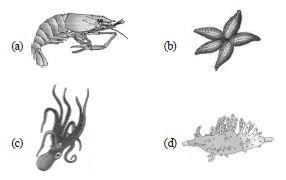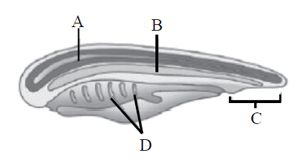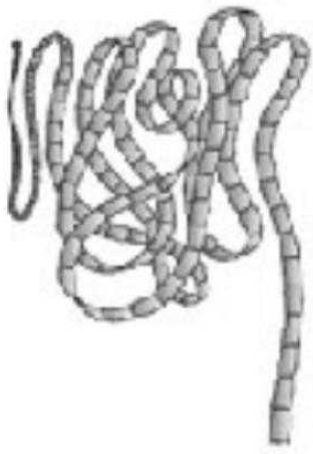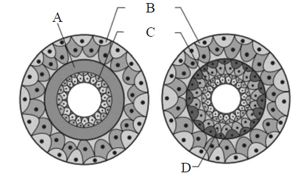Which of the following characteristic is probably most responsible for the great diversification of insects on land ?
Segmentation
Antennae
Bilateral symmetry
Exoskeleton
Correct Answer :
D. Exoskeleton
Exoskeleton is probably the most responsible for the great diversification of insects on land. An exoskeleton is the external skeletons that supports and protects an animal's body, in contrast to the internal skeleton (endoskeleton) of, for example, a human. Examples of exoskeleton animals include insects such as grasshoppers and cockroaches, and crustaceans such as crabs and lobsters.
Related Questions
Which of the following animal's body is covered by calcareous shell and unsegmented with a distinct head, muscular foot, and visceral hump?

Click to check answer
Click to check answer
Click to check answer
Click to check answer
Which of the following statement(s) is/are correct regarding phylum mollusca?
They are bilaterally symmetrical, triploblastic and coelomate animals.
Body is covered by a calcareous shell and is unsegmented with a distinct head, muscular foot and visceral hump.
The mouth contains a file-like rasping organ for feeding, called radula.
All of the above
Which of the following statement(s) is/are correct regarding phylum coelenterata?
(i) They are aquatic, mostly marine, sessile or freeswimming, radially symmetrical animals.
(ii) They have a central gastro-vascular cavity with a single opening called hypostome.
(iii) Digestion is extracellular and intracellular.
(iv) Examples are Sycon, Spongilla and Euspongia.
(i) and (ii)
(i) and (iv)
(i), (ii) and (iii)
All of these
The given figure shows some characteristic features marked as chordates. Identify the correct labelling A,B,C and D.

A-Notochord; B-Post-anal part; C-Gill slits; D-Nerve cord
A-Nerve cord; B-Notochord; C-Post-anal part; D-Gill slits
A-Notochord; B-Nerve cord; C-Gill slits; D-Post-anal part
A-Gill slits; B-Post-anal part; C-Nerve cord; D-Notochord
Tracheae of cockroach and mammal are similar in having
paired nature.
non-collapsible walls.
ciliated inner lining.
origin from head.
Which of the following characteristics is correct for reptilia?
Body covered with dry and cornified skin, scales over the body are epidermal, they do not have external ears.
Body is covered with moist skin and is devoid of scales, the ear is represented by a tympanum, alimentary canal, urinary and reproductive tracts open into a common cloaca.
Fresh water animals with bony endoskeleton and airbladder regulate buoyancy.
Marine animals with cartilaginous endoskeleton and body is covered with placoid scales.
Which of the following group of animals belongs to the same phylum?
Earthworm, pinworm, tapeworm
Prawn, scorpion, Locusta
Sponge, Sea anemone, starfish
Malarial parasite, Amoeba, mosquito
Which of the following statements is incorrect ?
Prawn has two pairs of antennae.
Nematocysts are characteristic feature of the phylum cnidaria.
Millipedes have two pairs of appendages in each segment of the body.
Animals that belong to phylum porifera are exclusively marine.
The following statement are associated with the occurrence of notochord. Identify the incorrect statement.
It is present only in larval tail in ascidians.
It is replaced by a vertebral column in adult frog.
It is absent throughout the life in humans from the very beginning.
It is present throughout life in Amphioxus.
Heart is three - chambered in reptiles, except
turtle
Chameleon
Naja (Cobra)
crocodile
Match the phylum given in column - I with the special features present in them given in column - II and choose the correct option.
| Column -I | Column- II |
|---|---|
| (Phylum) | (Special features present) |
| A. Porifera | I. Mammary glands |
| B. Mollusca | II. Cloaca |
| C. Ctenophora | III. Choanocytes |
| D. Amphibia | IV. Radula |
| E. Mammalia | V. Comb plates |
A III; B IV; C V; D II; E I
A IV; B III; C V; D II; E I
A III; B IV; C II; D V; E I
A III; B V; C IV; D II; E I
Which one of the following statement regarding coelom of given animals is correct?
Round worms (aschelminthes) are pseudocoelomates.
Molluscs are acoelomates.
Insects are pseudocoelomates.
Flatworms (platyhelminthes) are coelomates.
Aquatic annelids (like Nereis) possess lateral appendages called ______________, which help in swimming.
visceral hump
parapodia
radula
spicules
Which of the following phylum is being described by the given statements?
(i) They are bilaterally symmetrical,triploblastic, segmented and coelomate animals.
(ii) The body consists of head, thorax, abdomen and have jointed appendages.
(iii) Circulatory system is of open type.
(iv) Excretion takes place through malphigian tubules.
Arthropoda
Annelida
Mollusca
Echinodermata
Identify the figure with its correct name and phylum.

Sycon - Porifera
Aurelia - Coelenterata
Pleurobrachia - Ctenophora
Tapeworm - Platyhelminthes
Which of the following sets of animals give birth to young ones?
Platypus, Penguin, Bat, Hippopotamus.
Shrew, Bat, Cat, Kiwi.
Kangaroo, Hedgehog, Dolphin, Loris.
Lion, Bat, Whale, Ostrich.
The transition from aquatic to terrestrial lifestyles required many adaptations in the vertebrate lineage. Which of the following is not one of those adaptations ?
Switch from gill respiration to air-breathing lungs.
Improvements in water resistance of skin.
Alteration in mode of locomotion.
Development of feathers for insulation.
In ctenophora, the body bears _______ external rows of ciliated comb plates, which help in locomotion.
five
six
seven
eight
Hemichordates have now been placed with the nonchordates, close to echinoderms, because true
notochord is absent.
pharyngeal gill-slits are lacking.
dorsal nerve cord is absent.
heart is lacking.
Which of the following statement(s) is/are correct regarding class aves?
(i) The forelimbs are modified into wings and the hindlimbs generally have scales and are modified for walking, swimming or clasping the tree branches.
(ii) Heart is completely four-chambered.
(iii) They are warm- blooded (homoiothermous) animals i.e., they are able to maintain a constant body temperature.
(iv) They are oviparous and development is direct.
Both (i) and (iii)
Both (i) and (iv)
(i), (ii) and (iii)
All of these
Which of the following class is being described by the given statements (i - iv)?
(i) They are found in a variety of habitats- polar ice-caps, deserts, mountains, forests, grasslands and dark caves.
(ii) Most unique mammalian characteristic is the presence of mammary glands by which the young ones are nourished.
(iii) Heart is four-chambered.
(iv) Sexes are separate and fertilization is internal.
Reptilia
Aves
Mammalia
Amphibia
In amphibians, heart is ________ chambered.
two
three
four
none of these
Which of the following is a correct match of a phylum with their three examples?
PlatyhelminthesPlanaria, Schistosoma, Enterobius
Mollusca Loligo, Sepia, Octopus
Porifera Spongilla, Euplectella, Pennatula
Cnidaria Bonellia, Physalia, Aurelia
Flame cells present in platyhelminthes, are specialized in
respiration and absorption.
osmoregulation and circulation.
respiration and excretion.
osmoregulation and excretion.
The figure given below shows the germinal layers marked as A, B, C and D. Identify the label showing undifferentiated layer and its location?

A, Between B & C
B, Between A & C
C, Between C & D
D, Between A & B
Identify the correct characteristics of porifera.
- Commonly known as sea walnuts.
- Presence of ostia and collar cells.
- Exhibit tissue level of characteristics.
- It is the largest phylum of animal kingdom.
- The body is supported by spicules and sponging fibers.
- Contains cnidocytes which is used for defense, anchorage and capturing of prey.
(ii), (v) only
(i), (ii), (vi) only
(i), (ii), (iii), (iv) only
All of these.
A file like rasping organ for feeding, called radula, present in the phylum __________.
arthropoda
mollusca
echinodermata
chordata
Refer the following statement and answer the question. 'Name of X is derived from stinging capsules. It exhibits metagenesis containing two body forms in which sessile and cylindrical form is called Y and umbrella shaped and free swimming is called Z. Identify X, Y, and Z.
X - Coelenterate, Y - Polyp, Z - Medusa
X - Cnidarian, Y - Medusa, Z - Polyp
X - Ctenophora, Y - Radula, Z - Hypostome
X - Porifera, Y - Osculum, Z - Radula
In which of the phylum, excretory organ like proboscis gland is present?
Hemichordata
Chordata
Echinodermata
Annelida
Which of the following statement(s) is/are correct?
(i) Animals in which the cells are arranged in two embryonic layers, an external ectoderm and an internal endoderm, are called diploblastic animals.
(ii) Notochord is an ectodermally derived rod like structure formed on the ventral side during embryonic development in some animals.
(iii) In some animals, the body cavity is not lined by mesoderm, instead, the mesoderm is present as scattered pouches in between the ectoderm and endoderm and such a body cavity is called pseudocoelom.
Only (i)
Both (i) and (ii)
Both (i) and (iii)
All of these
